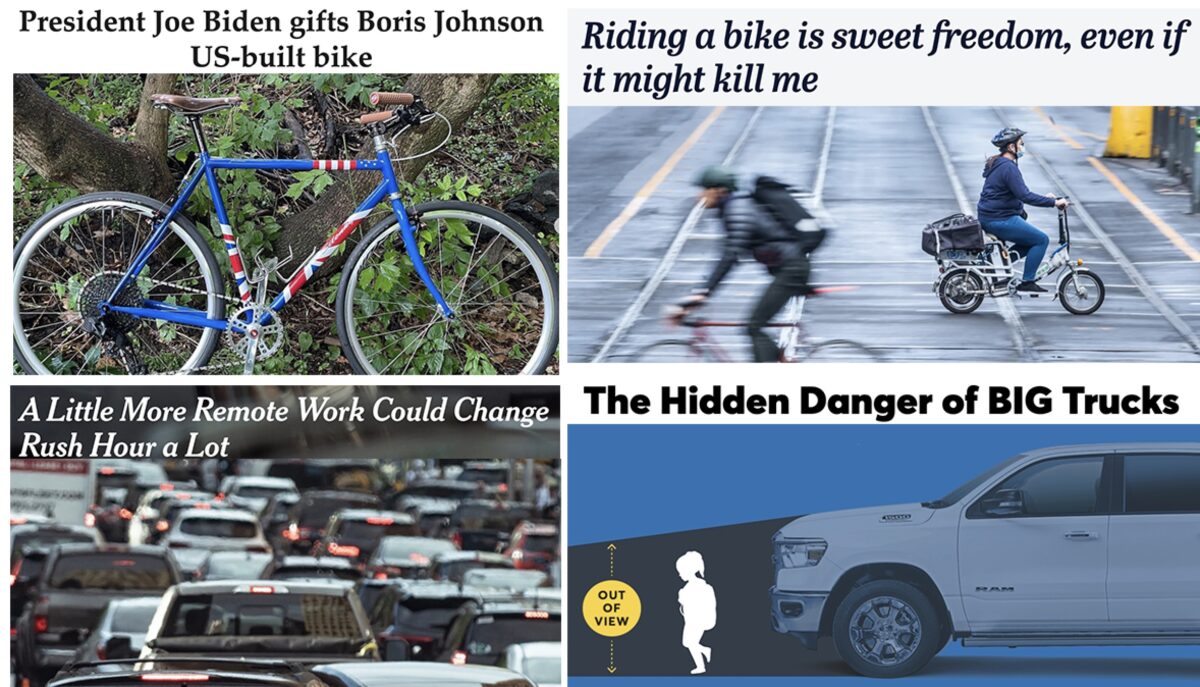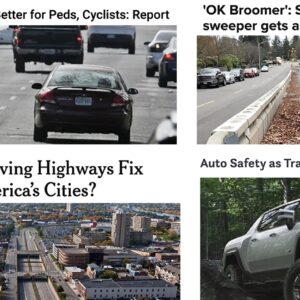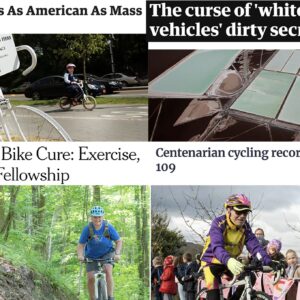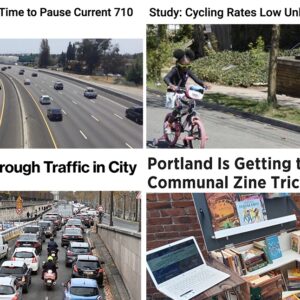
Good morning! Welcome to Monday.
Here are the most noteworthy items BikePortland readers and editors came across in the past seven days…
A Bilenky for Boris: The bike President Biden gifted to UK Prime Minister Boris Johnson was built in Philadelphia — and the handlebar came from the Ahearne Cycles shop in north Portland!
How green? A handy chart of carbon emissions by mode of travel (gleaned from existing research and news articles) puts bikes — even e-bikes — in two of the top four spots.
Big trucks, big problem: Even Consumer Reports understands the dangers of huge pickups and the need for better federal safety standards to regulate them.
An open letter to America: This person’s “Dear Chicago” post at Bike Lane Uprising could have been written about almost any major U.S. city and it’s extremely frustrating that we are still at this point in 2021.
Advertisement
How I came to love cycling: Similar to the above piece, this story from a B.C. journalist expresses the sheer delight of embracing cycling, even if there are moments of true peril on every ride.
Those without a car: I love the framing of low-car policies from a transport policymaker in Edinburgh who says, “When we only have policies that support car use, what we’re essentially saying is that 45 per cent don’t matter – well, they matter to me.”
Good and bad about e-bike boom: It’s crystal clear that e-bikes can save the world, so governments should do everything possible to clear up confusing rules and regulations.
Rush hour and the pandemic: Must-read in NY Times about how the pandemic impacted commute patterns and how everything we’ve known and planned for around peak-hour traffic might have changed for good.
Video of the Week: This is the one helmet PSA video to rule them all (and the fact that it comes from the Danish Road Safety Council makes it all the more noteworthy)…
— Jonathan Maus: (503) 706-8804, @jonathan_maus on Twitter and jonathan@bikeportland.org
— Get our headlines delivered to your inbox.
— Support this independent community media outlet with a one-time contribution or monthly subscription.






Thanks for reading.
BikePortland has served this community with independent community journalism since 2005. We rely on subscriptions from readers like you to survive. Your financial support is vital in keeping this valuable resource alive and well.
Please subscribe today to strengthen and expand our work.
A great video from Streetfilms showing car free streets during a festival. Also includes some great before and after footage of the street plaza program that New York has been doing for the past 15ish years.
The commute to downtown Portland from the NE quadrant has absolutely changed. Car traffic on major arteries is pretty much back to normal but the number of bike riders is well below half of 2019 levels. It bottomed out at 10% or less and is only gradually increasing. If we don’t have numbers we aren’t taken seriously, we aren’t seen and we aren’t safe. If we aren’t safe we’ll remain few.
I second everything the Chicago rider said. Dear Portland…
Our freinds, the stuff people, have decided what stuff is acceptable and what is to be piled in giant recycling heaps to build more steel. . . ?
How long did Beijing spend converting automatons from bicycle to automobile ?
Local bike shop hasnt had a size medium bicycle since March, although well stocked with size XS or XL mopeds being rebranded “e-bike”.
How ya think this is gonna play out kids ?
Most bike riders pass me. About half of them are on e-bikes. Does that mean half of bike riders are plugged in or is it just sampling error?
Anecdotal information is typically misleading.
I’m not tracking with this statement. What point are you trying to convey?
I’m not sure what China has to do with me riding a bike in PDX, but anyone who brings up China in random context comes off like someone who just wants to dunk on China.
Mopeds are small motor cycles with gas powered engines. Albeit, the term e-bike is very fluid. Cyclists should use the term pedelec to refer to their class 1 and 3 e-bikes.
Overall, I am not understanding what you are trying to say.
Chicago has come a long way, though.
My very first “job” out of grad school was as an intern with the Chicago Department of Environment. I was the DOE representative on the Mayor’s Bike Task Force.
[Citation needed]
Here ya go
Less CO2, less cars for instance.
What about two
cargo e-bike, it’s like a eco-freindly pickup
That opinion piece in The Age by Alice Clarke is from Melbourne, Australia, not BC.
Melbourne of course is in the Australian state of Victoria. And I don’t recall people being able to park on the left-hand side in such large numbers in BC as shown in the photo opposite of the protected bike lane.
I did some riding in Melbourne. It’s a beautiful, interesting city with some good bike infrastructure. But remembering to stay to the left on a bike path is even harder (at first) than it is in a car.
Yeah, I had the same issues in London and Cambridge. I was riding with a partner and every time we turned left on city streets, we immediately went on the right side (by instinct) and the person in back would have to yell out, “Move to the left!”
How Green?
An “autobus” is the type of diesel bus we use for public transit – I did not know that. And they aren’t very carbon-neutral, less so than an electric car.
Shoot, even Vikings at PSU wear helmets!
The BoJo friendship bike is awesome. Do you agree that Biden has been a pretty good ally for cycling so far?
Hell yes Biden has been good for biking! I mean, relative to U.S. presidents in general. He and his DOT Sec actually ride bikes and photos of them doing so are a big deal IMO. The bigger thing will be if they get infra spending bill to change from the status quo.
Imagine if the carbon emissions chart had included secondary emissions resulting from land-use patterns of car-dependent regions. I’m thinking of the larger homes that need more heating and cooling, bigger yards that need mowing, each home with its own washer/dryer and spa or whatever, and lots of rooms that need lots of stuff since each home is a castle.
Suburban sprawl is disgusting. Frankly, new single-family homes should be banned and single-family zoning should be abolished. Build more apartments, duplexes, condos, etc., and promote mixed-used development. Unfortunately Portland seems to be doing this in pretty much the most inequitable way possible, but that’s why we need to build tons of affordable apartments in addition to market-rate apartments. In my opinion, that’s by far the best way to reduce car-mode usage, rather than just trying to make driving difficult.
Until we prioritize mixed-use development and stop building McMansions in the suburbs, people will continue to use cars and our problem will continue to get worse.
Building tons of “affordable” apartments will take tons and tons of tax money to throw at developers who won’t develop without a large profit margin.
The City and County already have tons of tax money already for their so-called housing emergency and what progress have they made? A few hundred token “affordable” apartments.
You do realize you’ll never get single-family homes banned? People want space. I’m one of them. I’ve had to share walls with neighbors and it’ll be a cold day in H.E. double hockey sticks before I do that again. So thanks, but I’ll be keeping my 2,500 sq ft home with the lawn I mow with an electric mower, and never water.
Oh, I’m well aware it’s not going to happen, and it’s why I haven’t put any effort into advocating for the total banning of single-family houses; it’s more an idealistic solution than a practical solution. But it’s the only solution I can come up with that would actually work, and anything that gets us closer to it in terms of land-use policies is needed. Because people aren’t going to give up their cars if they live somewhere where the nearest grocery store, abundant restaurants, and other shops aren’t within walking distance. And if we actually taxed Nike and other similar entities we could pay for so, so much.
[Blank] wasn’t advocating for tearing down of all SFHs, or that you move out of yours; just advocating to abolish the construction of new ones. Even if that dramatic change happened today, there would still be many thousands of older SFHs around. Not everyone would necessarily choose to buy an SFH if they had more choices in family-friendly condos and apartments, but thanks to the “missing middle” they have little choice, pushing up demand for SFHs beyond its natural level. There might actually be a little less competition for single family homes if people had other, more-affordable options.
We in Minneapolis took a little step in the right direction a couple years ago, actually abolishing single-family-only zoning. The entire city is now zoned to allow triplexes, all transit corridors now allow multi-unit; commercial districts, high-density areas and areas where major transit lines intersect allow mid-rise. Are SFHs getting torn down at a higher rate than before? Nope. Sky hasn’t fallen.
Charlotte NC (pop 900,000) is updating their comp plan next week and is considering copying the Minneapolis model verbatim.
Cool. I think it’s a well-thought-out plan, and allows for a pretty wide variety of development types depending on the character of the neighborhood and the level of demand along the transit corridors.
It will be a couple decades before the development on the ground fully reflects what’s allowed in the Plan, but that’s the point: to steer the development that happens between now and 2040 in the direction of encouraging substantial new density in places that are best suited for it.
My Sprawl is disgusting perhaps, but Oak Grove Crime is not limited to just HW 99.
Good article about ridiculously giant pickup trucks. Beyond the noted safety problems, they’re now so big that at the boat launch at Willamette Park, the parking patrol person can no longer check to see if truck drivers have paid for parking from his car, because their dashboards are so high. In fact, some dashboards are so high, a 6′ tall person will have trouble seeing the dashboard when standing next to it. So I’ve seen the patrol person just drives past trucks and tickets cars.
Even the smaller “midsized” trucks like the Ford Ranger and Honda Ridgeline have this problem, and even the new Ford Maverick that debuted last week (a true compact pickup, something that hasn’t been on the market in over a decade), despite being smaller than the others it still has this unnecessarily vertical grille and horizontal hood. You just don’t need that much space under the hood! These trucks often have smaller engines than a minivan – why do they need a longer, higher hood? They don’t. It is done purely to make the trucks look more imposing.
Another absurd side effect of how big pickups have gotten is bed height. My understanding is even full-sized pickups’ beds were usually well under 30″ high as recently as 15-20 years ago, but current ones are 35-36″ high now. Ever try to load a bed full when it’s that high? Clearly, a lot of the people buying these pickups either don’t use them for hauling much, or have hired hands to do the work: if they actually did the work of loading these trucks themselves on a regular basis, there would be a market for lower bed heights. Again, so much about these vehicles is just for show now.
Thanks for mentioning the Maverick – I totally want one now.
Pretty astonishing that they’re going to sell a 40mpg hybrid pickup for $22k (making it the cheapest Ford you can buy). Even if I don’t approve of the front-end design, I recognize that it will be a massive game-changer.
So disappointed to read this helmet propaganda here. “the fact that it comes from the Danish Road Safety Council…” uh well: “The Danish Road Safety Council (Rådet for Sikker trafik) used to be called The Council for Greater Traffic Safety (Rådet for Større Færdselssikkerhed). In 2009, they changed names and that is basically the only concrete thing the Council has done in many, many years.”
http://www.copenhagenize.com/2012/11/close-danish-road-safety-council.html
“There is evidence that cycling levels decline when helmets are promoted and collapse when they become compulsory (Liggett et al 2004, 12)
…Because cycling tends to be safest where there are many cyclists (Jacobsen 2003), and most dangerous in places with few cyclists, and because helmet promotion campaigns reduce the overall numbers of cyclists, helmet promotion increases the risk of cycling. The relationship between increased cycling and increased safety appears to be confirmed by the experiences of the Netherlands and Denmark, which have high levels of cycling, very low rates of helmet wearing, and low rates of death and serious injury among cyclists;”
http://www.copenhagenize.com/2009/09/fear-of-cycling-03-helmet-promotion.html